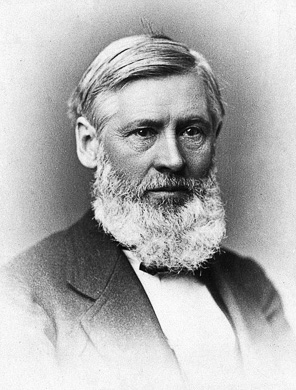BOTANY FOR YOUNG PEOPLE AND COMMON SCHOOLS
How Plants Grow
A Simple Introduction to Structural Botany
by Asa Gray
Originally published in 1858 and now in the public domain.
CHAPTER II.
HOW PLANTS ARE PROPAGATED OR MULTIPLIED IN NUMBERS.
SECTION III. -- Flowers (page 1 of 3).
§ 1. Their Arrangement on the Stem.
168. Inflorescence is the term used by botanists for flower-clusters generally, or for the way blossoms are arranged on the stem. Everything about this is governed by a very simple rule, which is this:
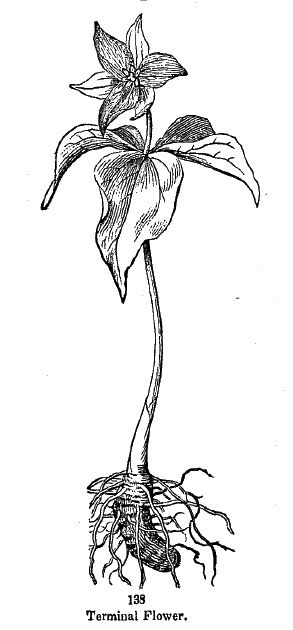

169. Flower-buds appear in the same places that common buds (that is, leaf-buds) do; and they blossom out in the order of their age, the earliest-formed first, and so on in regular succession.
Now the place for buds is in the axils of the leaves (axillary buds, 58), and at the end of the stem (terminal bud, 57), so these are also the places from which flowers spring.
Fig. 138 is a Trillium, with its flower terminal, that is, from the summit of the stem. Fig. 139 is a piece of Moneywort, with axillary flowers, i.e., from the axils of the leaves. The Morning-Glory (Fig. 4) also has its flowers axillary.
170. Solitary Flowers. In both these cases the blossoms are solitary, that is, single.
There is only one on the plant in Trillium (Fig. 138). In Fig. 139, there is only one from the same axil, and although, as the stem grows on, flowers appear in succession, they are so scattered, and so accompanied by leaves, that they cannot be said to form a flower-cluster.
171. Flower-Clusters are formed whenever the blossoms are more numerous or closer, and the accompanying leaves are less conspicuous.
Fig. 140 is a cluster (like that of Lily of the Valley, Fig. 3) of the kind called a raceme.
On comparing it with Fig. 139, we may perceive that it differs mainly in having the leaves, one under each blossom-stalk, reduced to little scales, which are inconspicuous. In both, the flowers really spring from the axils of leaves. So they do in all the following kinds of flower-clusters, until we reach the Cyme.

172. The leaves of a flower-cluster take the name of Bracts. These are generally very different from the ordinary leaves of the plant, commonly much smaller, and often very small indeed, as in Fig. 140. In the figures 141 to 144, the bracts are larger, and more leaf-like. They are the leaves from whose axil the flower arises.
Sometimes there are bracts also on the separate flower-stalks (as on the lower ones in Fig. 140); to distinguish these we call them Bractlets.
173. The flower-stalk or footstalk of a blossom is called a Peduncle (96). So the flowers in Fig. 138, 139, &c. are peduncled or stalked.
But in Fig. 141 they are sitting on the stem, or sessile.
174. In clusters we need to distinguish two kinds of flower-stalks, namely, the stalk 'of the whole cluster, if there be any, and the stalk of each blossom. In such cases we call the stalk of the cluster the Peduncle, and the stalk of the individual flowers we name the Pedicel.
In the Lily of the Valley (Fig. 3, as in Fig. 140), there is the peduncle or general flower-stalk (which is here a continuation of the main stem), and then the flowers all have pedicels of their own.
175. Kinds of Flower-Clusters. Of those which bear their flowers on the sides of a main stalk, in the axils of leaves or bracts, the principal kinds are the Raceme, the Corymb, the Umbel, the Head, and the Spike with its varieties; also the Panicle.
In the head and the spike the flowers are sessile. In the others they have pedicels or footstalks of their own.
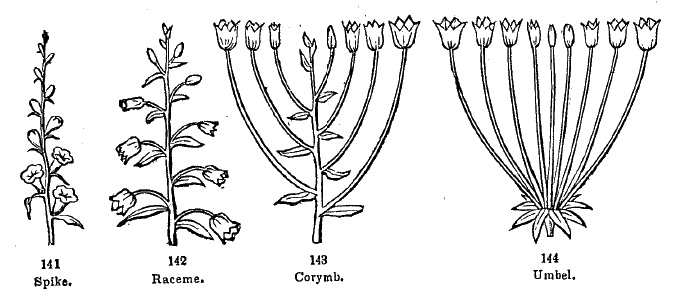
176. A Raceme is a cluster with the blossoms arranged along the sides of a main flower-stalk, or its continuation, and all on pedicels of about the same length. A bunch of Currant-blossoms or berries, or the graceful cluster of the Lily of the Valley (Fig. 3, 140) are good illustrations; Fig.142 shows the plan of the raceme.
Notice that a raceme always blossoms from the bottom to the top, in regular order, because the lower buds are of course the oldest.
177. A Corymb is a flat-topped or convex cluster, like that of Hawthorn. Fig. 143 shows the plan of it.
It is plainly the same as a raceme with the lower pedicels much longer than the uppermost. Shorten the body, or axis, of a corymb so that it is hardly perceptible, and we change it into
178. An Umbel, as in Fig.144. This is a cluster in which the pedicels all spring from about the same level, like the rays or sticks of an umbrella, from which it takes its name.
The Milkweed and Primrose bear their flowers in umbels.
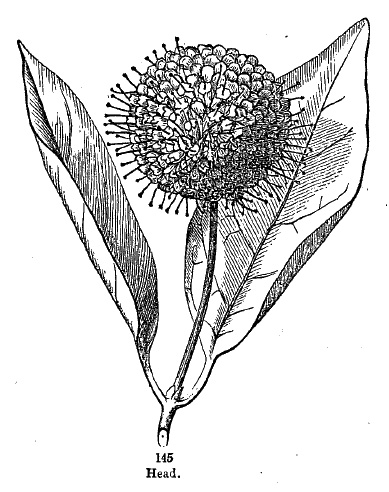
179. The outer blossoms of a corymb or an umbel plainly answer to the lower blossoms of a raceme. So the umbel and the corymb blossom from the circumference towards the centre, the outer flower-buds being the oldest.
By that we may know such clusters from cymes.
180. A Head is a flower-cluster with a very short body, or axis, and without any pedicels to the blossoms, or hardly any, so that it has a rounded form.
The Button-bush (Fig. 145), the Thistle, and the Red Clover are good examples.
181. It is plain that an umbel would be changed into a head by shortening its pedicels down to nothing; or, contrarily, that a head would become an umbel by giving stalks to its flowers.
182. A Spike is a lengthened flower-cluster, with no pedicels to the flowers, or hardly any. Fig. 141 gives the plan of a spike, and the common Mullein and the Plantain are good examples.
A head would become a spike by lengthening its axis. A raceme would become a spike by shortening its pedicels so much that they could hardly be seen.
The Catkin and the Spadix are only sorts of spike.

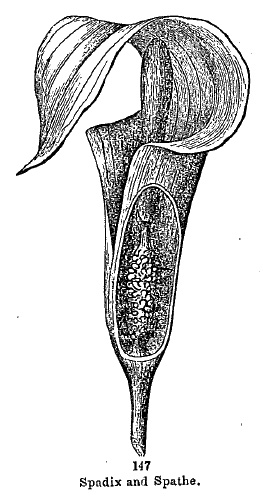
183. A Catkin or Ament is a spike with scaly bracts. The flowers of the Willow, Poplar, Alder, and Birch (Fig. 146) are in catkins.
184. A Spadix is a spike with small flowers crowded on a thick and fleshy body or axis. Sweet-Flag and Indian-Turnip are common examples. In Indian-Turnip (Fig. 147) the spadix bears flowers only near the bottom but is naked and club-shaped above.
And it is surrounded by a peculiar leaf or bract in the form of a hood.
185. Such a bract or leaf enwrapping a spike or cluster of blossoms is named a Spathe.
186. A set of bracts around a flower-cluster, such as those around the base of the umbel in Fig. 144, is called an involucre.
187. Any of these clusters may be compound.
That is, there may be racemes clustered in racemes, making a compound raceme, or corymbs in corymbs, or umbels in umbels, making a compound umbel, as in Caraway (Fig. 148), Parsnip, Parsley, and all that family.
The little umbels of a compound umbel are called Umbellets, and their involucre, if they have any, is called an Involucel.

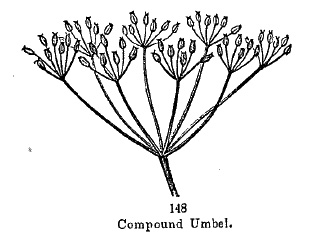
188. A Panicle is an irregularly branching compound flower-cluster, such as would be formed by a raceme with its lower pedicels branched.
Fig. 149 shows a simple panicle, the branches, or what would be the pedicels, only once branched. A bunch of Grapes and the flower-cluster of Horsechestnut are more compound panicles.
A crowded compound panicle of this sort has been called a Thyrse.
189. A Cyme is the general name of flower-clusters of the kind in which a flower always terminates the stem or main peduncle, and each of its branches. The plan of a cyme is illustrated in the following figures.
Fig. 150, to begin with, is a stem terminated by a flower, which plainly comes from a terminal bud or is a terminal flower. Fig. 151 is the same, which has started a branch from the axil of each of the uppermost leaves; each of these ends in a flower-bud. Fig. 152 is the same, with the side branches again branched in the same way, each branch ending in a flower-bud. This makes a cluster looking like a corymb, as shown in Fig. 143; but
observe that here in the cyme the middle flower, a, which ends the main stem, blossoms first; next, those flowers marked b; then those marked c, and so on, the centre one of each set being the earliest; while in the corymb the blossoming begins with the outermost flowers and proceeds regularly towards the centre.
The Elder, the Cornel, and the Hydrangea (Fig. 169) have their blossoms in cymes many times branched in this way; that is, they have compound cymes.

190. A Fascicle is only a close or very much crowded cyme, with very short footstalks to the flowers, or none at all, as the flower-cluster of Sweet-William.
2a. Forms and Kinds of Flowers. CLICK HERE
2b. Forms and Kinds of Flowers. CLICK HERE
Analysis of the Section.
168. Arrangement of Flowers, or Inflorescence. 169. Situation of Flower-buds, terminal and axillary. 170, Solitary flowers. 171. Flower-clusters. 172. Bracts and Bractlets. 173, 174. Flower-stalks: Peduncle and Pedicels. 175. Kinds of flower-clusters. 176. Raceme; order of opening of the blossoms. 177. Corymb. 178. Umbel. 179. Comparison with Raceme, &c. 180. Head. 181. Comparison with the Umbel, and, 182. the Spike. 183. Catkin or Ament. 184. Spadix. 185. Its Spathe, 186, Involucre. 187. Compound Clusters: Umbellets; Involucel. 188. Panicle; Thyrse. 189. Cyme; 190. Fascicle.

